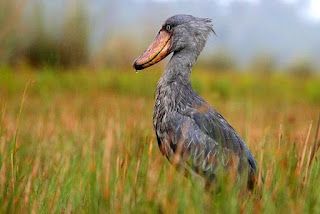On
our way to Murchison Falls National Park, we normally stop by the road side and
search the swampy marshes on the right and side right after Luwero town. Every
once in 9 times, we will see the elusive shoe bill stork in its marshy
dwellings. When seen, it is a sight to
behold, as its prehistoric looks strike as much fear in us as they do in the
frogs, baby crocodiles, lung fish and the rodents this giant of a bird eats.
The
shoebill also known as the whale bird can grow to four feet in
height with wingspan of seven feet. It has an oversized beak and exceedingly
large eyes. The shoebill has a pre historic dinosaur like look to match its
scary nature. Shoebills have been known to live for up to
50 years.
The shoebill is often found in a
still stance as it hunts with great patience. Shoebills can silently perch at
the water’s edge for hours waiting for the right time to snap down on their favourite
fish.However the shoebill can also be loud as it
claps the mandibles of its bill together as a display, producing a loud, hollow
sound. This is done during mating season to attract mates.
Shoebills normally lay two eggs
but only one hatchling will survive to fledge. The larger shoebill will
normally fight and chase off the smaller hatchling from the nest.
Shoebills can be seen across East
and central Africa in Zambia, Tanzania, Sudan and Uganda. In Uganda, shoebills can be seen on the Nile delta in
Murchison Falls national park, in the Mabamba swamp near Entebbe and in
wetlands near Luweero. Shoebills are an endangered species and are listed on
CITES.

Comments
Post a Comment